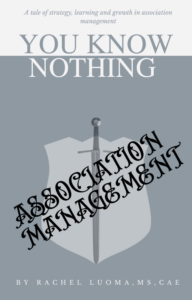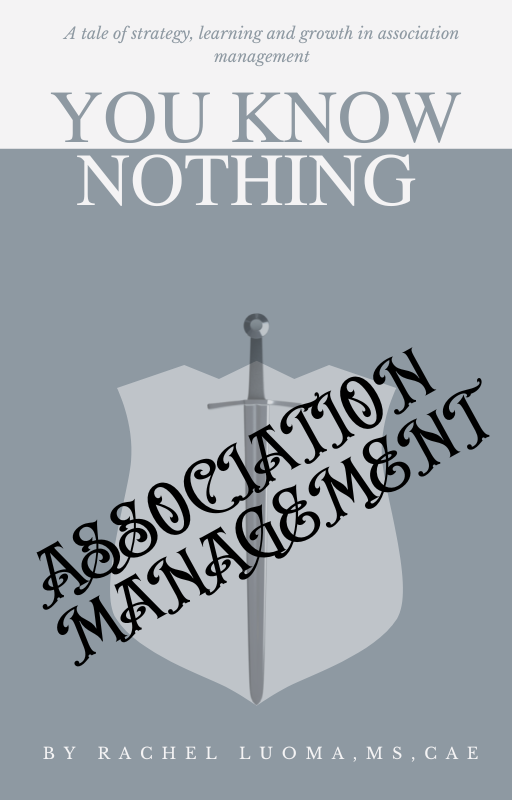You Know Nothing of Association Strategy Jon Snow
By Vice President Rachel Luoma, MS, CAE
One of my association clients is going through the strategic planning process with Lowell Aplebaum of Vista Cova. As I have worked with associations for over 15 years, I have facilitated strategic planning meetings before. I thought I knew a great deal about the strategic planning process. Heck, I have written articles and given lectures about the topic. Going through the process with an external facilitator, however, especially one as wise and as talented as Lowell Aplebaum, has taught me so much. What I learned is that, ‘I know nothing Jon Snow.’
going through the strategic planning process with Lowell Aplebaum of Vista Cova. As I have worked with associations for over 15 years, I have facilitated strategic planning meetings before. I thought I knew a great deal about the strategic planning process. Heck, I have written articles and given lectures about the topic. Going through the process with an external facilitator, however, especially one as wise and as talented as Lowell Aplebaum, has taught me so much. What I learned is that, ‘I know nothing Jon Snow.’
Our strategic planning process started with a series of planning calls between staff and our facilitator. Lowell wanted to understand the big picture of the industry, the organization, and the leadership. He asked what we were hoping to accomplish through this process, and along the way ensured that our expectations for what we wanted and what he could deliver were in alignment. From these conversations a draft agenda was created.
Vista Cova then released a survey to our leadership, followed up with pre-session call. During this call, staff presented a primer which shared the history of the organization, some of the big picture challenges and some of the industry trends. This was a critical step in the process. It allowed our leadership to have a greater understanding of where the organization currently is, so there could then be dialogue about where the organization should go. It also allowed volunteer leaders to provide preliminary thoughts about the association’s strengths and weaknesses in both a confidential and small group setting. Our onsite agenda was refined using the responses and the pre-session call.
TAKE AWAY #1 You have to look backwards to look forwards. It is important to reflect on where the organization has been. What are the historical trends? What were the challenges and successes of the past? What were the goals, strategies and tactics thus far?
The day of the session was spectacular. We started out with a reflective exercise of what we do well as an organization and where we could do better. We talked about the role of the volunteer leader and what success looks like for organizations with great volunteer leaders. We talked about the rules of engagement for the strategy session so everyone was on the same page.
From there, each volunteer leader shared their vision of a successful tomorrow for the association. I loved seeing our volunteer leaders speak with such passion and enthusiasm! Then Lowell asked if the current vision and mission of the organization adequately captured what we just described – the one we wanted to see in the future. The answer was a resounding no.
So, we broke into small groups and discussed the updates needed to align the mission and vision with what the volunteer leaders envisioned. Now, I have seen groups work on mission and vision before and it has been painful. Groups arguing whether the word “and” or “or” should be used is hardly the best use of time. This, however, was done in a beautiful way that allowed for key words to be identified and suggested changes to be made. However, instead of going down the mission and vision rabbit hole, the work was delegated to a task force responsible for refining and bringing back to the group at another meeting.
TAKE AWAY #2 You cannot have a strategy session without talking about mission and vision. Simply ask yourself, does the mission and vision adequately define the statement of the organization’s future and capture how your organization intends to get there? Does it provide the organization’s leadership with guidance to make better decisions? Is it inspirational? Does it help those not in the profession understand what your organization is about (who you are and what you do)? If any answer is no, then you have to look at your mission and vision. Focus on the strategic elements.
While we were working on mission and vision, Lowell was extrapolating key information from our visioning session to create the framework for the organization’s strategy goals. We broke into small groups to refine goal areas and outline a success statement for each goal. Then we looked for areas of overlap to narrow down, consolidate and finalize our goal areas. From there, volunteer leaders were invited to select the goal they wanted to work on (to ensure their work was meaningful). Within each goal area, the groups worked to identify their goal statements, identified what success would look like for each goal statement and created strategies to generate a pathway to success.
TAKE AWAY #3 Don’t rush the process. We scheduled an entire day for strategic planning but we could have really used more time together. In an ideal situation, scheduling a day and a half or two full days provides the group with time to reflect, time to adapt and time to punt to the second day. A tired group is not an effective group.
In the end, our group walked out of the strategy session gushing about how it was the best strategy session they had ever participated in. There was a renewed sense of passion and commitment and a willingness and desire to focus on strategic initiatives and critical conversations. That night at dinner the group continued to discuss strategy, identify challenges, brainstorm solutions and ask important questions about why and how things were being done. It was inspirational!
TAKE AWAY #4 Successful organizations ensure that strategy is top of mind and permeates through all areas of discussion. Work to ensure that volunteer leaders are continuously discussing strategy. Make sure one strategic item is added to each board agenda. Move strategy discussions to the top of your agenda. Add a consent agenda to accept reports instead of spending time presenting reports. Make sure your mission and vision are present throughout your board meeting and your goal areas are added to your agendas.
So, I implore you to think about strategy in a different way. Yes, I understand that not all associations can bring in a strategic planning facilitator, but that does not mean that you cannot make incremental changes to make strategy a priority. So, go forth and strategize!

– Rachel has been involved in associations for over 15 years and has experience in all areas of association management. She holds a Master’s Degree in Adult Education and holds the Certified Association Executive designation. Rachel was named a Young and Aspiring Professional by Association Trends Magazine, Executive of the Year by the Florida Society of Association Executives and was recognized as one of Association Forum’s and USAE’s Forty Under 40® Awards recipients. She is a former Chair of the Florida Society of Association Executives. Fun Fact(s): When she’s not doing her association management thing, Rachel rocks out as lead singer with Tallahassee’s hottest cover band – Suckerdust!





